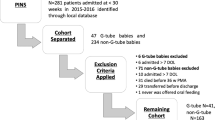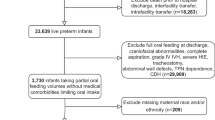Abstract
Objective
To evaluate feeding outcomes in preterm infants discharged with feeding tubes (FT).
Study design
Retrospective study comparing infants ≤30 weeks gestational age discharged with a nasogastric tube (NGT) or surgically placed feeding tube (spFT) from 2012–2020. The primary outcome was feeding status at 12 months corrected age, defined as full oral feeds (FOF) or feeding tube dependence (FTD) if ongoing FT use.
Results
217 infants were included: 130 discharged with an NGT (60%), 87 with spFT (40%). More NGT infants achieved FOF (NGT = 76%, spFT=24%, p < 0.001). FTD was associated with small for gestational age (aOR= 2.75, p = 0.034), severe bronchopulmonary dysplasia (aOR= 2.36, p = 0.029), and continuous feeds (aOR= 4.06, p < 0.001). Increased oral intake at discharge decreased FTD odds (aOR=0.74, p = 0.010). Infants with spFT had higher healthcare utilization for FT complications (spFT=60%, NGT = 19%, p < 0.001).
Conclusions
These findings can guide FT selection and optimize follow-up for infants at risk of FTD.
This is a preview of subscription content, access via your institution
Access options
Subscribe to this journal
Receive 12 print issues and online access
$259.00 per year
only $21.58 per issue
Buy this article
- Purchase on SpringerLink
- Instant access to full article PDF
Prices may be subject to local taxes which are calculated during checkout

Similar content being viewed by others
Data availability
The data that support the findings of this study are available on reasonable request from the corresponding author, AL. The data are not publicly available, as they are stored on a secure REDCap server at Emory University.
References
Viswanathan S, Jadcherla S. Feeding and swallowing difficulties in neonates. Clin Perinatol. 2020;47:223–41.
Sharp WG. Intensive multidisciplinary feeding intervention for high-risk infants. Clin Perinatol. 2023;50:239–51.
Pados BF, Hill RR, Yamasaki JT, Litt JS, Lee CS. Prevalence of problematic feeding in young children born prematurely: a meta-analysis. BMC Pediatr. 2021;21:110.
Lau C. Oral feeding in the preterm infant. Neoreviews. 2006;7:e19–27.
Warren MG, Do B, Das A, Smith PB, Adams-Chapman I, Jadcherla S, et al. Gastrostomy tube feeding in extremely low birthweight infants: frequency, associated comorbidities, and long-term outcomes. J Pediatr. 2019;214:41–46.e5.
Alshaikh B, Yusuf K, Dressler-Mund D, Mehrem AA, Augustine S, Bodani J, et al. Rates and determinants of home nasogastric tube feeding in infants born very preterm. J Pediatr. 2022;246:26–33.e2.
Greene NH, Greenberg RG, O’Brien SM, Kemper AR, Miranda ML, Clark RH, et al. Variation in gastrostomy tube placement in premature infants in the United States. Am J Perinatol. 2019;36:1243–9.
Howk AA, Sternthal JL, Pakvasa MA, Connor B, Keene SD. Enteral tube feeding selection at NICU discharge and resource utilization. J Perinatol. 2022;43:647–52.
Jadcherla SR, Khot T, Moore R, Malkar M, Gulati IK, Slaughter JL. Feeding methods at discharge predict long-term feeding and neurodevelopmental outcomes in preterm infants referred for gastrostomy evaluation. J Pediatr. 2017;181:125–130.e1.
Lagatta JM, Uhing M, Acharya K, Lavoie J, Rholl E, Malin K, et al. Actual and potential impact of a home nasogastric tube feeding program for infants whose neonatal intensive care unit discharge is affected by delayed oral feedings. J Pediatr. 2021;234:38–45.e2.
Khalil ST, Uhing MR, Duesing L, Visotcky A, Tarima S, Nghiem-Rao TH. Outcomes of infants with home tube feeding: comparing nasogastric vs gastrostomy tubes. J Parenter Enter Nutr. 2017;41:1380–5.
Williams SL, Popowics NM, Tadesse DG, Poindexter BB, Merhar SL. Tube feeding outcomes of infants in a Level IV NICU. J Perinatol. 2019;39:1406–10.
Matharu P, Cristea AI, Slaven JE, Becker S, Niehaus JZ. Feeding outcomes for infants with bronchopulmonary dysplasia discharged on nasogastric feeds. Am J Perinatol. 2021;38:897–900.
Gehle DB, Chapman A, Gregoski M, Brunswick M, Anderson E, Ramakrishnan V, et al. A predictive model for preterm babies born < 30 weeks gestational age who will not attain full oral feedings. J Perinatol. 2022;42:126–31.
Von Elm E, Altman DG, Egger M, Pocock SJ, Gøtzsche PC, Vandenbroucke JP. The Strengthening the Reporting of Observational Studies in Epidemiology (STROBE) statement: guidelines for reporting observational studies. J Clin Epidemiol. 2008;61:344–9.
Hutcheon JA, Jacobsen GW, Kramer MS, Martinussen M, Platt RW. Small size at birth or abnormal intrauterine growth trajectory: which matters more for child growth? Am J Epidemiol. 2016;183:1107–13.
Jensen EA, Dysart K, Gantz MG, McDonald S, Bamat NA, Keszler M, et al. The diagnosis of bronchopulmonary dysplasia in very preterm infants. an evidence-based approach. Am J Respir Crit Care Med. 2019;200:751–9.
Stoll BJ, Puopolo KM, Hansen NI, Sánchez PJ, Bell EF, Carlo WA, et al. Early-onset neonatal sepsis 2015 to 2017, the rise of Escherichia coli, and the need for novel prevention strategies. JAMA Pediatr. 2020;174:e200593.
Raol N, Schrepfer T, Hartnick C. Aspiration and dysphagia in the neonatal patient. Clin Perinatol. 2018;45:645–60.
Goldberg DL, Becker PJ, Brigham K, Carlson S, Fleck L, Gollins L, et al. Identifying malnutrition in preterm and neonatal populations: recommended indicators. J Acad Nutr Diet. 2018;118:1571–82.
Hasan SU, Lodha AK, Yusuf K, Dalgleish S. Physiological basis of neonatal aerodigestive difficulties in chronic lung disease. Clin Perinatol. 2020;47:277–99.
Bapat R, Gulati IK, Jadcherla S. Impact of SIMPLE feeding quality improvement strategies on aerodigestive milestones and feeding outcomes in BPD infants. Hosp Pediatr. 2019;9:859–66.
Dalgleish SR, Kostecky LL, Blachly N. Eating in “SINC”: safe individualized nipple-feeding competence, a quality improvement project to explore infant-driven oral feeding for very premature infants requiring noninvasive respiratory support. Neonatal Netw. 2016;35:217–27.
Sadrudin Premji S, Chessell L, Stewart F. Continuous nasogastric milk feeding versus intermittent bolus milk feeding for preterm infants less than 1500 grams. Cochrane Database Syst Rev. 2021;6:CD001819.
Krom H, De Winter JP, Kindermann A. Development, prevention, and treatment of feeding tube dependency. Eur J Pediatr. 2017;176:683–8.
Bouchard ME, Stewart DH, Hall M, Many BT, Vacek JC, Papastefan S, et al. Trends in gastrostomy tube placement with concomitant Nissen fundoplication for infants and young children at Pediatric Tertiary Centers. Pediatr Surg Int. 2021;37:617–25.
Hatch LD, Scott TA, Walsh WF, Goldin AB, Blakely ML, Patrick SW. National and regional trends in gastrostomy in very low birth weight infants in the USA: 2000–2012. J Perinatol. 2018;38:1270–6.
McGrath-Morrow SA, Hayashi M, Aherrera AD, Collaco JM. Respiratory outcomes of children with BPD and gastrostomy tubes during the first 2 years of life. Pediatr Pulmonol. 2014;49:537–43.
Gulati IK, Sultana Z, Jadcherla SR. Approach to feeding difficulties in neonates and infants. Clin Perinatol. 2020;47:265–76.
Jensen EA, Munson DA, Zhang H, Blinman TA, Kirpalani H. Anti-gastroesophageal reflux surgery in infants with severe bronchopulmonary dysplasia. Pediatr Pulmonol. 2015;50:584–7.
Li R, Chandler NM, Germain A, Green A, Machry J, Ramos-Gonzalez G, et al. Nissen fundoplication in infants with severe bronchopulmonary dysplasia: a propensity-matched analysis. J Surg Res. 2024;299:353–8.
Ng K, Lefton-Greif MA, McGrath-Morrow SA, Collaco JM. Factors that impact the timing and removal of gastrostomy placement/Nissen fundoplication in children with bronchopulmonary dysplasia. Am J Perinatol. 2023;40:672–9.
White BR, Zhang C, Presson AP, Friddle K, DiGeronimo R. Prevalence and outcomes for assisted home feeding in medically complex neonates. J Pediatr Surg. 2019;54:465–70.
Adams-Chapman I, Bann CM, Vaucher YE, Stoll BJ. Association between feeding difficulties and language delay in preterm infants using Bayley Scales of Infant Development-Third Edition. J Pediatr. 2013;163:680–685.e3.
Meyers JM, Bell EF, Duncan AF, Guillet R, Stoll BJ, D’Angio CT, et al. Neurodevelopmental outcomes among extremely premature infants with linear growth restriction. J Perinatol. 2019;39:193–202.
Author information
Authors and Affiliations
Contributions
AL: Conceived study design, completed data collection, drafted initial manuscript, revised manuscript based on feedback from co-authors. BM: Assisted with research methodology, contributed to data interpretation, provided revisions to manuscript. ZH: Performed statistical analysis, assisted with creation of tables and figures and interpretation of statistical analysis, provided revisions to manuscript. NR: Assisted with research methodology, contributed to data interpretation, provided revisions to manuscript. WGS: Assisted with research methodology, contributed to data interpretation, provided revisions to manuscript. HK: Provided guidance on study design, oversaw interpretation of statistical analysis, reviewed and edited the manuscript. All authors reviewed and approved the final manuscript.
Corresponding author
Ethics declarations
Competing interests
Dr. Karpen has the following disclosures: Prolacta Bioscience, INC: research grant, honoraria and Progeny Health, Scientific Advisory Board Member. Dr. Lakhani, Dr. McElhanon, Dr. He, Dr. Raol, and Dr. Sharp declare no potential competing interests.
Ethics approval
Study approval was obtained from the Emory University Institutional Review Board (STUDY00003538), and a waiver of informed consent was granted. The study was performed in accordance with the Declaration of Helsinki.
Additional information
Publisher’s note Springer Nature remains neutral with regard to jurisdictional claims in published maps and institutional affiliations.
Rights and permissions
Springer Nature or its licensor (e.g. a society or other partner) holds exclusive rights to this article under a publishing agreement with the author(s) or other rightsholder(s); author self-archiving of the accepted manuscript version of this article is solely governed by the terms of such publishing agreement and applicable law.
About this article
Cite this article
Lakhani, A., McElhanon, B., He, Z. et al. Feeding outcomes of preterm infants discharged with feeding tubes. J Perinatol (2025). https://doi.org/10.1038/s41372-025-02422-x
Received:
Revised:
Accepted:
Published:
DOI: https://doi.org/10.1038/s41372-025-02422-x



